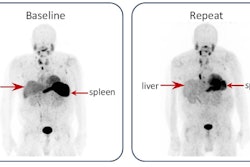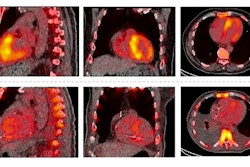A team at Harvard University in Cambridge, MA, has tested the first PET radiotracer specifically for visualizing cardiac amyloidosis, also known as "stiff heart syndrome," according to a recent study.
In a pilot study in 46 patients, the group found that the tracer -- called iodine-124 (I-124) evuzamitide -- demonstrated significant uptake by abnormal amyloid protein in the heart and allowed physicians to discriminated between patients with the disease and healthy subjects.
"Visual interpretation of I-124 evuzamitide PET/CT images identified cardiac amyloidosis in all participants," wrote nuclear medicine physicians and first author Olivier Clerc, MD, in a study published September 6 in JACC: Cardiovascular Imaging.
Cardiac amyloidosis develops when, for reasons that remain unclear, amyloid proteins misfold and build up in the myocardium. This restricts cardiac function and can lead to heart failure and death.
PET radiotracers such as F-18 florbetapir, which was developed to visualize beta-amyloid deposits in Alzheimer's disease patients, have shown significant promise for visualizing this molecular activity. However, these stand-in tracers show low myocardial uptake in the most frequent forms of the disease, namely transthyretin amyloidosis (ATTR) and light-chain amyloidosis (AL), the researchers explained.
Conversely, I-124 evuzamitide is a "pan-amyloid" imaging agent that has proven in animal studies to bind to amyloid fibrils in all types of amyloid deposits. Moreover, several effective therapies that appear to be able to slow the progression of the disease are now clinically available or are in clinical trials, they added.
"Amyloid quantification has become the key next step to understand the effects of therapy and to potentially advance early diagnosis and treatment of cardiac amyloidosis," they wrote.
In a pilot study, the researchers included 12 participants with cardiac AL, 12 with the wild-type ATTR subtype, two with hereditary amyloidosis, and 20 control subjects without amyloidosis. All participants underwent imaging using I-124 evuzamitide and F-18 florbetapir PET/CT, with uptake in the left and right ventricles used for comparative measurements.
According to the findings, substantial cardiac uptake of I-124 evuzamitide was observed in all participants regardless of the type, while all control participants had no visual cardiac uptake. The performance between F-18 florbetapir and I-124 evuzamitide were similar, but there were notable differences.
Specifically, for patients with wild-type ATTR disease, I-124 evuzamitide uptake was higher in the left ventricle than was seen with F-18 florbetapir (p = 0.002), they noted.
"In AL-[cardiomyopathy], discrimination performance is similar to F-18 florbetapir. In ATTRwt-[cardiomyopathy], performance may be better with I-124 evuzamitide," the researcher wrote.
The study was a pilot project and the first to evaluate the I-124 radiotracer's ability to quantify cardiac amyloid in patients, the researchers noted. As such, results are preliminary, yet promising.
"With further validation, quantitative I-124 evuzamitide uptake may be particularly useful to diagnose early disease or to monitor disease progression in cardiac amyloidosis," the group concluded.
The full article is available here.





















